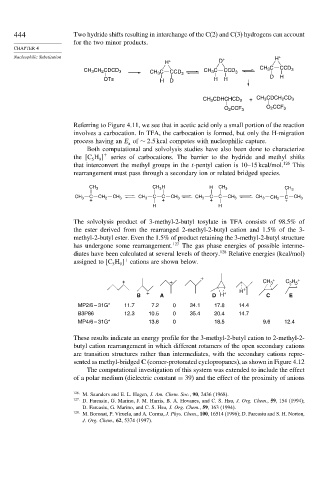Page 463 - Advanced Organic Chemistry Part A - Structure and Mechanisms, 5th ed (2007) - Carey _ Sundberg
P. 463
444 Two hydride shifts resulting in interchange of the C(2) and C(3) hydrogens can account
for the two minor products.
CHAPTER 4
Nucleophilic Substitution + H +
H + D
CH 3 C CCD
CH 3 CH 2 CDCD 3 CH 3 C CCD 3 CH 3 C CCD 3 3
OTs H D H H D H
CH 3 CDHCHCD 3 + CH 3 CDCH 2 CD 3
O 2 CCF 3
O 2 CCF 3
Referring to Figure 4.11, we see that in acetic acid only a small portion of the reaction
involves a carbocation. In TFA, the carbocation is formed, but only the H-migration
process having an E of ∼ 2 5kcal competes with nucleophilic capture.
a
Both computational and solvolysis studies have also been done to characterize
the C H + series of carbocations. The barrier to the hydride and methyl shifts
9
5
that interconvert the methyl groups in the t-pentyl cation is 10–15 kcal/mol. 126 This
rearrangement must pass through a secondary ion or related bridged species.
H H
CH 3 CH 3 CH 3 CH 3
C C C C C
CH 3 CH 2 CH 3 CH 3 CH 3 CH 3 CH 3 CH 3 CH 2 C CH 3
+ + + +
H H
The solvolysis product of 3-methyl-2-butyl tosylate in TFA consists of 98.5% of
the ester derived from the rearranged 2-methyl-2-butyl cation and 1.5% of the 3-
methyl-2-butyl ester. Even the 1.5% of product retaining the 3-methyl-2-butyl structure
has undergone some rearrangement. 127 The gas phase energies of possible interme-
diates have been calculated at several levels of theory. 128 Relative energies (kcal/mol)
+
assigned to C H cations are shown below.
9
5
+ + +
+ + CH 3 C 2 H 5
H +
+
B + A D H C E
MP2/6 – 31G* 11.7 7.2 0 34.1 17.8 14.4
B3P86 12.3 10.5 0 35.4 20.4 14.7
MP4/6 – 31G* 13.6 0 18.5 9.6 12.4
These results indicate an energy profile for the 3-methyl-2-butyl cation to 2-methyl-2-
butyl cation rearrangement in which different rotamers of the open secondary cations
are transition structures rather than intermediates, with the secondary cations repre-
sented as methyl-bridged C (corner-protonated cyclopropanes), as shown in Figure 4.12
The computational investigation of this system was extended to include the effect
of a polar medium (dielectric constant = 39) and the effect of the proximity of anions
126
M. Saunders and E. L. Hagen, J. Am. Chem. Soc., 90, 2436 (1968).
127 D. Farcasiu, G. Marino, J. M. Harris, B. A. Hovanes, and C. S. Hsu, J. Org. Chem., 59, 154 (1994);
D. Farcasiu, G. Marino, and C. S. Hsu, J. Org. Chem., 59, 163 (1994).
128
M. Boronat, P. Viruela, and A. Corma, J. Phys. Chem., 100, 16514 (1996); D. Farcasiu and S. H. Norton,
J. Org. Chem., 62, 5374 (1997).

